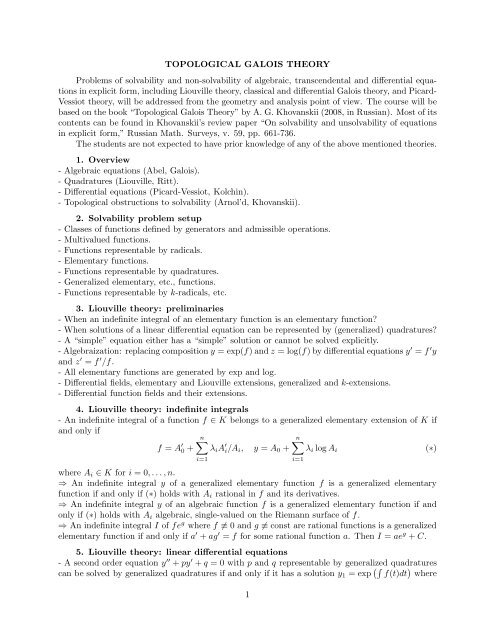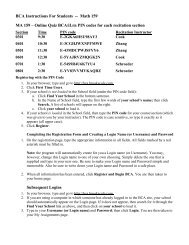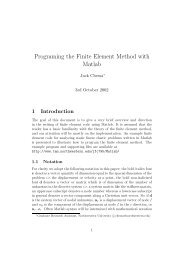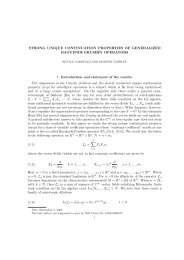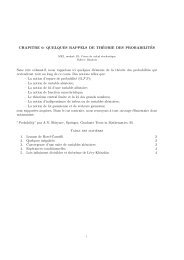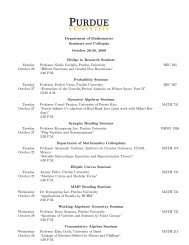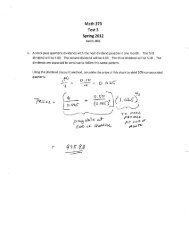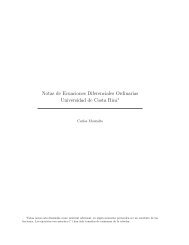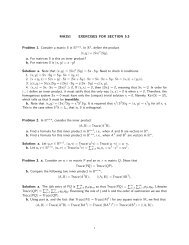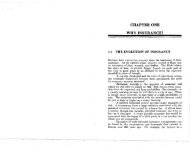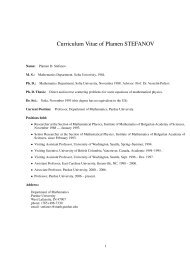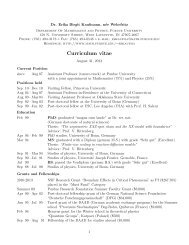TOPOLOGICAL GALOIS THEORY Problems of solvability and non ...
TOPOLOGICAL GALOIS THEORY Problems of solvability and non ...
TOPOLOGICAL GALOIS THEORY Problems of solvability and non ...
You also want an ePaper? Increase the reach of your titles
YUMPU automatically turns print PDFs into web optimized ePapers that Google loves.
<strong>TOPOLOGICAL</strong> <strong>GALOIS</strong> <strong>THEORY</strong><br />
<strong>Problems</strong> <strong>of</strong> <strong>solvability</strong> <strong>and</strong> <strong>non</strong>-<strong>solvability</strong> <strong>of</strong> algebraic, transcendental <strong>and</strong> differential equations<br />
in explicit form, including Liouville theory, classical <strong>and</strong> differential Galois theory, <strong>and</strong> Picard-<br />
Vessiot theory, will be addressed from the geometry <strong>and</strong> analysis point <strong>of</strong> view. The course will be<br />
based on the book “Topological Galois Theory” by A. G. Khovanskii (2008, in Russian). Most <strong>of</strong> its<br />
contents can be found in Khovanskii’s review paper “On <strong>solvability</strong> <strong>and</strong> un<strong>solvability</strong> <strong>of</strong> equations<br />
in explicit form,” Russian Math. Surveys, v. 59, pp. 661-736.<br />
The students are not expected to have prior knowledge <strong>of</strong> any <strong>of</strong> the above mentioned theories.<br />
1. Overview<br />
- Algebraic equations (Abel, Galois).<br />
- Quadratures (Liouville, Ritt).<br />
- Differential equations (Picard-Vessiot, Kolchin).<br />
- Topological obstructions to <strong>solvability</strong> (Arnol’d, Khovanskii).<br />
2. Solvability problem setup<br />
- Classes <strong>of</strong> functions defined by generators <strong>and</strong> admissible operations.<br />
- Multivalued functions.<br />
- Functions representable by radicals.<br />
- Elementary functions.<br />
- Functions representable by quadratures.<br />
- Generalized elementary, etc., functions.<br />
- Functions representable by k-radicals, etc.<br />
3. Liouville theory: preliminaries<br />
- When an indefinite integral <strong>of</strong> an elementary function is an elementary function?<br />
- When solutions <strong>of</strong> a linear differential equation can be represented by (generalized) quadratures?<br />
- A “simple” equation either has a “simple” solution or cannot be solved explicitly.<br />
- Algebraization: replacing composition y = exp(f)<strong>and</strong>z =log(f) by differential equations y ′ = f ′ y<br />
<strong>and</strong> z ′ = f ′ /f.<br />
- All elementary functions are generated by exp <strong>and</strong> log.<br />
- Differential fields, elementary <strong>and</strong> Liouville extensions, generalized <strong>and</strong> k-extensions.<br />
- Differential function fields <strong>and</strong> their extensions.<br />
4. Liouville theory: indefinite integrals<br />
- An indefinite integral <strong>of</strong> a function f ∈ K belongs to a generalized elementary extension <strong>of</strong> K if<br />
<strong>and</strong> only if<br />
f = A ′ n<br />
0 + λiA ′ n<br />
i/Ai, y = A0 +<br />
(∗)<br />
λi log Ai<br />
i=1<br />
i=1<br />
where Ai ∈ K for i =0,...,n.<br />
⇒ An indefinite integral y <strong>of</strong> a generalized elementary function f is a generalized elementary<br />
function if <strong>and</strong> only if (∗) holdswithAirational in f <strong>and</strong> its derivatives.<br />
⇒ An indefinite integral y <strong>of</strong> an algebraic function f is a generalized elementary function if <strong>and</strong><br />
only if (∗) holdswithAialgebraic, single-valued on the Riemann surface <strong>of</strong> f.<br />
⇒ An indefinite integral I <strong>of</strong> feg where f ≡ 0<strong>and</strong>g≡ const are rational functions is a generalized<br />
elementary function if <strong>and</strong> only if a ′ + ag ′ = f for some rational function a. ThenI = aeg + C.<br />
5. Liouville theory: linear differential equations<br />
- A second order equation y ′′ + py ′ + q =0withp <strong>and</strong> q representable by generalized quadratures<br />
can be solved by generalized quadratures if <strong>and</strong> only if it has a solution y1 =exp f(t)dt where<br />
1
f is algebraic over the differential field K generated by p <strong>and</strong> q.<br />
- Higher order equations (Liouville, Mordukhai-Boltovskii, Picard-Vessiot). An equation y (n) +<br />
p1y (n−1) + ...+ pny =0withpi representable by generalized quadratures can be solved by generalized<br />
quadratures if <strong>and</strong> only if<br />
1) It has a solution y1 =exp f(t)dt where f belongs to an algebraic extension K1 <strong>of</strong> the<br />
differential field K generated by pi.<br />
2) The differential equation for z = y ′ − (y ′ 1 /y1)y <strong>of</strong> the order (n-1) with coefficients in K1,<br />
obtained by reducing the order <strong>of</strong> the original equation, is solvable by generalized quadratures<br />
over K1.<br />
6. Galois theory: Solvability <strong>of</strong> algebraic equations by radicals<br />
-LetV be an algebra over a field K <strong>and</strong> G a finite commutative group <strong>of</strong> automorphisms <strong>of</strong> V .<br />
Assume that char(K) =0<strong>and</strong>K contains n-th roots <strong>of</strong> 1. Then each x ∈ V is a sum <strong>of</strong> n-th roots<br />
<strong>of</strong> elements <strong>of</strong> the invariant algebra V0.<br />
-ForV as above, let G be a finite solvable group <strong>of</strong> automorphisms <strong>of</strong> V .Theneachx ∈ V can be<br />
obtained from the elements <strong>of</strong> V0 by extracting roots <strong>and</strong> summation.<br />
- Permutation group S(n) <strong>and</strong> <strong>solvability</strong> <strong>of</strong> equations <strong>of</strong> degree ≤ 4.<br />
- Lagrange interpolation polynomials, eigenvectors <strong>of</strong> commuting matrices, <strong>and</strong> formulas for solutions<br />
<strong>of</strong> equations <strong>of</strong> degree ≤ 4.<br />
- Galois group <strong>of</strong> an algebraic equation. Galois extension <strong>of</strong> a field <strong>and</strong> its Galois group.<br />
- Main theorem <strong>of</strong> Galois theory: Let P be a Galois extension <strong>of</strong> a field K with the Galois group<br />
G. The Galois correspondence between subgroups H <strong>of</strong> G <strong>and</strong> intermediate fields F , K ⊆ F ⊆ P ,<br />
is one-to-one. An intermediate field F is a Galois extension <strong>of</strong> K, with the Galois group G/H, if<br />
<strong>and</strong> only if the group H corresponding to F is a normal subgroup <strong>of</strong> P .<br />
- Galois extension <strong>of</strong> the field <strong>of</strong> coefficients <strong>and</strong> the change <strong>of</strong> the Galois group <strong>of</strong> an algebraic<br />
equation.<br />
- An algebraic equation over a field K is solvable by radicals if <strong>and</strong> only if its Galois group is<br />
solvable.<br />
- Abel’s theorem: The general algebraic equation <strong>of</strong> degree ≥ 5 is not solvable by radicals.<br />
- k-solvable groups <strong>and</strong> reduction <strong>of</strong> the degree <strong>of</strong> an algebraic equation.<br />
7. Picard-Vessiot theory: Solvability <strong>of</strong> linear differential equations by quadratures<br />
- Division with remainder for linear differential operators.<br />
- Reduction <strong>of</strong> order <strong>of</strong> a linear differential equation.<br />
- Wronskians <strong>and</strong> the analog <strong>of</strong> Viète formula for linear differential equations.<br />
- Galois group <strong>of</strong> a linear differential equation. Picard-Vessiot extension <strong>of</strong> a differential field.<br />
- Main theorem <strong>of</strong> Picard-Vessiot theory: Let P be a Picard-Vessiot extension <strong>of</strong> a differential field<br />
K, with the Galois group G. The Galois correspondence between Zariski closed subgroups H <strong>of</strong><br />
G <strong>and</strong> intermediate differential fields F , K ⊆ F ⊆ P , is one-to-one. An intermediate differential<br />
field F is a Picard-Vessiot extension <strong>of</strong> K, with the Galois group G/H, if <strong>and</strong> only if the group H<br />
corresponding to F is a normal subgroup <strong>of</strong> P .<br />
- Picard-Vessiot extension <strong>of</strong> the field <strong>of</strong> coefficients <strong>and</strong> the change <strong>of</strong> the Galois group <strong>of</strong> a linear<br />
differential equation.<br />
-Solvable,k-solvable, almost solvable algebraic groups <strong>and</strong> <strong>solvability</strong> <strong>of</strong> linear differential equations<br />
by quadratures, k-quadratures, generalized quadratures, resp.<br />
- Kolchin’s theory: Quasi-compact <strong>and</strong> anticompact groups. Special triangular <strong>and</strong> diagonal groups.<br />
Solvability <strong>of</strong> linear differential equations by integrals, integrals <strong>and</strong> radicals, integrals <strong>and</strong> algebraic<br />
functions, exponentials <strong>of</strong> integrals, exponentials <strong>of</strong> integrals <strong>and</strong> algebraic functions.<br />
- Picard-Vessiot extensions with triangular Galois groups.<br />
2
8. Univariate topological Galois theory<br />
- Fields <strong>of</strong> meromorphic functions on algebraic curves <strong>and</strong> ramified coverings <strong>of</strong> the Riemann surfaces.<br />
- Galois group <strong>of</strong> an algebraic equation as its monodromy group.<br />
- Topological obstructions to representability <strong>of</strong> functions by radicals: An algebraic function is<br />
representable by radicals (k-radicals) if <strong>and</strong> only if its monodromy group is solvable (k-solvable).<br />
⇒ (Arnol’d) An algebraic function not representable by radicals is also not representable by radicals<br />
<strong>and</strong> any entire functions.<br />
⇒ (Arnol’d) If a meromorphic function g is topologically equivalent to an elliptic function f then<br />
g is an elliptic function (possibly with different periods than those <strong>of</strong> f). In particular, g is not<br />
elementary.<br />
- Dense sets <strong>of</strong> ramification points <strong>and</strong> monodromy groups with a continuum <strong>of</strong> elements. Functions<br />
analytic outside a “forbidden” set A <strong>and</strong> their A-monodromy groups. Closed monodromy groups.<br />
- Functions with at most countable set <strong>of</strong> singular points (S-functions). Closedness under differentiation,<br />
integration, composition, substitution into a meromorphic function, solution <strong>of</strong> algebraic<br />
<strong>and</strong> linear differential equations.<br />
- Topological obstructions to representability <strong>of</strong> functions by quadratures, generalized quadratures,<br />
k-quadratures.<br />
9. Topological Picard-Vessiot theory<br />
- Monodromy <strong>of</strong> a linear differential equation <strong>and</strong> its Galois group.<br />
- Fuchsian equations. Frobenius theorem: Single-valued solutions <strong>of</strong> a Fuchsian equation are rational<br />
functions.<br />
⇒ Zariski closure <strong>of</strong> the monodromy group <strong>of</strong> a Fuchsian equation coincides with its Galois group.<br />
- A Fuchsian equation is solvable by quadratures (k-quadratures, generalized quadratures) if <strong>and</strong><br />
only if its monodromy group is solvable (k-solvable, almost solvable).<br />
- Monodromy group <strong>of</strong> a system <strong>of</strong> linear differential equations <strong>and</strong> its Galois group.<br />
- Regular singular points <strong>of</strong> a system <strong>of</strong> linear differential equations. Regular systems <strong>of</strong> linear<br />
differential equations.<br />
- For a regular system <strong>of</strong> linear differential equations, the differential field generated by its solutions<br />
is a Picard-Vessiot extension <strong>of</strong> the field <strong>of</strong> rational functions. Its Galois group coincides with the<br />
Zariski closure <strong>of</strong> its monodromy group.<br />
- Each component <strong>of</strong> each solution <strong>of</strong> a regular system <strong>of</strong> linear differential equations can be expressed<br />
by quadratures (k-quadratures, generalized quadratures) if <strong>and</strong> only if its monodromy group<br />
is solvable (k-solvable, almost solvable).<br />
10. Multivariate topological Galois theory<br />
- Will be covered if time permits.<br />
3


